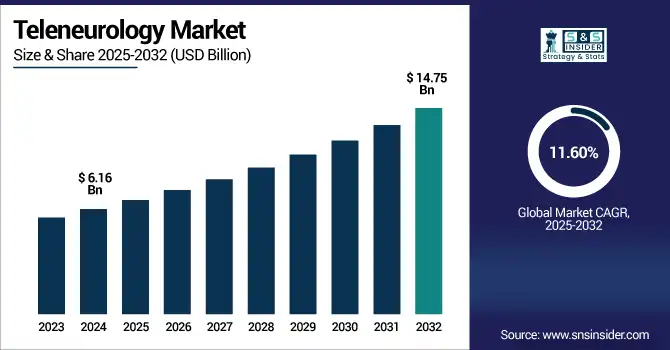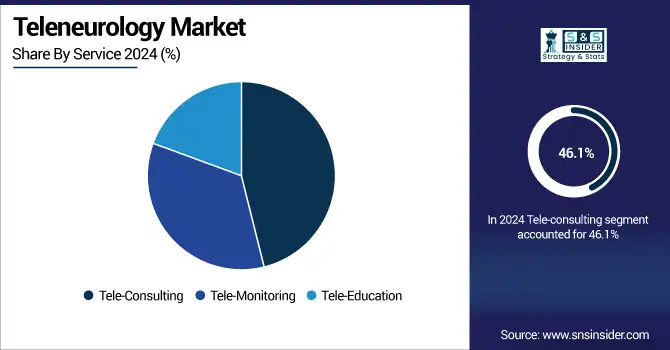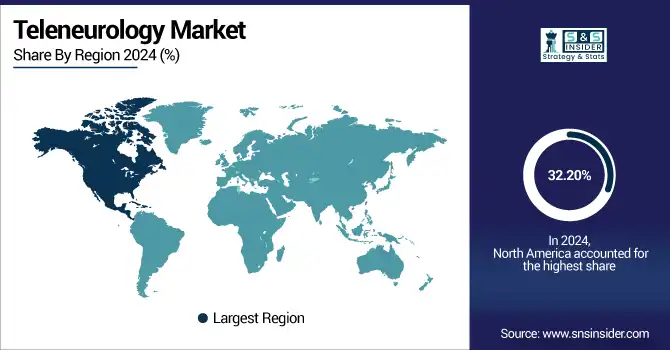Teleneurology Market Report Scope & Overview:
The teleneurology market size was valued at USD 6.16 billion in 2024 and is expected to reach USD 14.75 billion by 2032, growing at a CAGR of 11.60% over the forecast period of 2025-2032.

To Get more information on Teleneurology-Market - Request Free Sample Report
The global teleneurology market is undergoing rapid development due to the rise in demand for telehealth services for neurological care; however, this type of care is seen to prevail in remote and underserved areas. Growth in consultation, monitoring, and diagnosis via telehealth for stroke, epilepsy, Parkinson's disease, and multiple sclerosis is driving up the number of people suffering from neurological disorders. Digital health tools, wearable devices, and AI-based platforms are also adding to the quality of care delivered. Furthermore, rising awareness, affordability, and ease of use are stimulating wider acceptance at the hospital, clinic, and patient level globally.
The U.S. teleneurology market size was valued at USD 1.51 billion in 2024 and is expected to reach USD 3.51 billion by 2032, growing at a CAGR of 11.20% over the forecast period of 2025-2032.
The U.S. dominates the North American teleneurology market growth, owing to an excellent healthcare infrastructure and favorable telehealth policies, and early adaptation of teleneurology platforms for the management of strokes and chronic neurological diseases. The USA's preeminence within the region is further fortified by provisions for robust insurance coverage and public-private investment in stroke networks and tele-neurology services.
Market Dynamics:
Drivers
-
Rising Prevalence of Neurological Disorders is Propelling the Market Growth
With aging populations, lifestyle changes, and improved diagnosis, the burden of neurological disorders such as stroke, epilepsy, Parkinson’s disease, dementia, and multiple sclerosis has been progressively increasing globally. With the increasing number of patients suffering from these diseases, demand for timely and specialist neurological care is rising. Teleneurology is a feasible means of providing rapid access to neurologists, especially for patients living in remote or underserved areas, to meet the increasing demand for diagnosis, treatment, and long-term management of neurological diseases.
Americans with brain ailments such as those from dementia (Alzheimer's), Parkinson's disease, or multiple sclerosis (MS) may have to wait longer, or face difficulties in assessing a neurologist, according to a study published in the April, 2013 online edition of Neurology, the medical journal of the American Academy of Neurology.
According WHO, more than 50 million people globally suffer from epilepsy—80 % of these folks reside in low- and middle-income nations, further emphasising the global burden of this ailment and the need for remote solutions for neurological care.
-
Telecommunication and Digital Health Technology Advancements are Driving the Market Growth
The delivery of virtual neurological care has improved vastly over time with rapid advances in internet infrastructure, mobile device accessibility, and secure video conferencing platforms. Novel agents, including artificial intelligence (AI)-based diagnostic tools, wearable health monitors, and near-end real-time data sharing, have enabled neurologists in many circumstances to remotely evaluate patients with extraordinary precision. Aside from facilitating real-time monitoring and early interventions, these digital tools, in turn, make teleneurology scalable and efficient too, prompting even wider uptake across healthcare systems across the globe.
For instance, with nearly 36 % of weekly consultations conducted virtually, when it comes to academic facilities report makes it evident that telehealth is widely recognized by experts, according to the American Medical Association.
Restraint
-
The market is Limited to Grow Due to Inaccessible Digital Infrastructure in Rural and Low-Income Areas
The lack of dependable digital infrastructure in rural, remote, and low-income areas is one of the significant obstacles to the growth of the teleneurology market. If it is a teleneurology service, then it needs & has to stable internet connection along with an operating device, or in case possible smartphone, tablet, or a computer, & a user-friendly telehealth platform. Still, there are regions, especially in developing nations and in neglected regions of developed countries, that continue to face inadequate network services, bandwidth, and low digital literacy. The clinical benefits of teleneurology cannot be fully realized with the current market for that health technology due to the digital divide.
Segmentation Analysis:
By Application
In 2024, the stroke segment dominated the teleneurology market share with a 28.44% share % owing to the wide geographical implementation of telestroke programs among hospitals and emergency care units. Acute stroke care requires immediate neuro evaluation and intervention, and teleneurology allows for quick remote diagnostic ability and treatment decision-making, particularly in underserved/coupled geographical locations. Telestroke services have been successfully implemented into many stroke systems of care, decreasing time-to-treatment (door-to-needle time) and subsequently improving patient outcomes, increasing access to neurologists, and matching patients with the best conforming treatment. Encouraging reimbursement policies and clinical practice guidelines have followed suit, helping to facilitate its incorporation into routine stroke care pathways.
The parkinson segment is anticipated to experience the fastest growth during the forecast period, owing to the rising prevalence of the disease along with the requirement for continuous long-term management. However, teleneurology has considerable benefits in the care of patients with Parkinson’s, such as remote motor symptom monitoring, medication titration, and early specialist referrals. Improvements in wearable technologies and mobile health applications will improve the method of tracking disease progression and treatment response. Furthermore, rising preference among patients toward home-based solutions and reduced number of hospital visits is facilitating the telehealth solutions in Parkinson's disease management.
By Service
The tele-consulting segment dominated the teleneurology market in 2024 with a 46.1% market share, which is the essential step of remote neurological care, allowing patients to communicate with neurologists for initial assessment, follow-up appointments, and treatment planning. This service has been popularized in hospitals, outpatient clinics, and rural health settings to fill the specialist access gap for disorders such as stroke, epilepsy, and headaches. The most accessible and scalable service in teleneurology. The ease of virtual consultations, along with the development of secure video platforms and increasing availability of suitable devices (for instance, smartphones), have rendered teleconsulting the most available and scalable service in teleneurology.
The tele-monitoring segment is projected to grow at the highest rate over the forecast period, owing to the increasing need for real-time, ongoing, and continuous monitoring of chronic neurological conditions such as Parkinson's disease, epilepsy, and multiple sclerosis during the forecast period. Such emerging technologies, including wearable devices, mobile health apps, and AI-based tracking tools, enable remote assessment of patient status, medications received, and symptom variations between medications. Tele-monitoring of chronic diseases plays a vital role in improving disease management, reducing unnecessary hospital visits, and increasing patient engagement as healthcare systems are moving from a reactive/one-size-fits-all approach to personalized and preventive care.

By End Use
The providers segment led the teleneurology market share in 2024 with 56.19% due to the increased adoption of telehealth platforms in hospitals, specialty neurology clinics, and healthcare systems. Teleneurology solutions have been incorporated by medical providers in order to improve access to neurological knowledge and expertise, especially in acute care environments (e.g., telestroke networks). They allow neurologists to get involved in the cases remotely, improving the efficiency and minimizing the strain on face-to-face services. This is attributed to the favorable reimbursement policies and growing requirement for neurologist assistance in healthcare facilities in both urban and rural areas, which will further benefit the segment.
In the forecast period, the patients segment is expected to be the fastest-growing segment as several patients are becoming more proactive and actively looking for neurological care in the comfort of their homes. Improved digital literacy, increased acceptance of consultations conducted over the internet, and the exploding number of mobile health apps are giving patients the power to manage chronic neurological disorders (Parkinson's disease, epilepsy, and migraines, among others) from afar. Moreover, telemedicine practice has become more commonplace as a result of the pandemic, and a larger push for patient-centered care that will likely see considerable uptake from those with chronic neurological health needs.
Regional Analysis:
North America dominated the teleneurology market with a 32.20% market share in 2024, owing to a well-established healthcare infrastructure, higher acceptance of telehealth technologies, and a considerable number of neurologists present in integrated virtual care networks. Telestroke applications and remote neurology services have been widely adopted among hospitals and EDs across the region, the US. The region has been further cemented in the leadership position thanks to favorable reimbursement policies, regulatory support for telemedicine, and high levels of digital literacy among patients and providers. Consequently, government and private investments have improved accessibility and quality of teleneurology services in urban and rural settings.
The teleneurology market in Asia Pacific is emerging as a significantly growing region owing to booming healthcare digitalization, an increasing number of neurological diseases, and high demand for specialist care in a convenient approach. Telehealth platforms are being quickly adopted in countries with a remote or underserved neurologist population, such as India, China, and Japan. The regional growth is driven by government-supported telemedicine projects, increasing internet availability, and to be more knowledgeable about virtual treatment of neurological disorders. In addition, the cost-effectiveness and ease of scalability of teleneurology solutions are well-suited to meet the needs of the large, heterogeneous, and aging population of the region.
The teleneurology market trends in Europe are growing substantially during the forecast period and will be supported by a developed digital health infrastructure in Europe and increasing efforts in neurological care in this region. Countries such as Germany, France, and the U.K. have been much more successful than the U.S. in incorporating telestroke and tele-epilepsy programs into their national health systems, thereby improving access to specialty care for urban and rural patients alike. Moreover, increasing funding towards telehealth platforms, neurological exploration, and cross-country digital health programs in turn are driving demand for teleneurology services in the region.
The teleneurology market is expected to grow at a moderate pace in emerging regions such as Latin America and the Middle East & Africa (MEA), owing to improving telehealth infrastructure and rising prevalence of neurological conditions. In Latin America, the use of teleconsultation in neurology is spreading, tailored to areas with a lack of resources and communication, which may offer these services to reach this patient population.
Teleneurology market analysis has started gaining some traction across the MEA region; Saudi Arabia has invested in the telemedicine framework, and similarly, the UAE is also witnessing investment in healthcare, particularly in telemedicine. Despite having a slower growth rate relative to developed markets, the market is slowly growing, but this is mainly due to the favourable government policies, increased internet accessibility, and the rising demand for neurological treatment.

Get Customized Report as per Your Business Requirement - Enquiry Now
Key Players
The teleneurology market companies, Teladoc Health, SOC Telemed, Eagle Telemedicine, TeleSpecialists, LLC, ScienceSoft, Ceribell, Inc., CorticaCare, Inc., Epitel, Inc., Empatica Inc., AdvancedMD, and other players.
Recent Developments
-
March 2025 – Teladoc Health, a global leader in virtual care, released upgrades to its proprietary care delivery platform, Prism, to expand care coordination with in-market care providers and digital health partners. The new upgrade provides improved referral capabilities to integrate seamlessly with in-market and virtual care partners.
-
July 2024 – Ceribell, Inc., a medical technology developer for neurological treatment, issued results of a new multi-center retrospective study. The study compared patient outcomes with the Ceribell system to routine electroencephalography (EEG), showing the system can improve detection and treatment of serious neurological diseases.
| Report Attributes | Details |
|---|---|
| Market Size in 2024 | USD 6.16 Billion |
| Market Size by 2032 | USD 14.75 Billion |
| CAGR | CAGR of 11.60% From 2025 to 2032 |
| Base Year | 2024 |
| Forecast Period | 2025-2032 |
| Historical Data | 2021-2023 |
| Report Scope & Coverage | Market Size, Segments Analysis, Competitive Landscape, Regional Analysis, DROC & SWOT Analysis, Forecast Outlook |
| Key Segments | • By Application (Stroke, Parkinson, Epilepsy, Headache, Multiple Sclerosis, Dementia, Others) • By Service (Tele-Consulting, Tele-Monitoring, Tele-Education) • By End Use (Patients, Providers, Payers) |
| Regional Analysis/Coverage | North America (US, Canada, Mexico), Europe (Germany, France, UK, Italy, Spain, Poland, Turkey, Rest of Europe), Asia Pacific (China, India, Japan, South Korea, Singapore, Australia, Rest of Asia Pacific), Middle East & Africa (UAE, Saudi Arabia, Qatar, South Africa, Rest of Middle East & Africa), Latin America (Brazil, Argentina, Rest of Latin America) |
| Company Profiles | Teladoc Health, SOC Telemed, Eagle Telemedicine, TeleSpecialists, LLC, ScienceSoft, Ceribell, Inc., CorticaCare, Inc., Epitel, Inc., Empatica Inc., AdvancedMD, and other players. |

